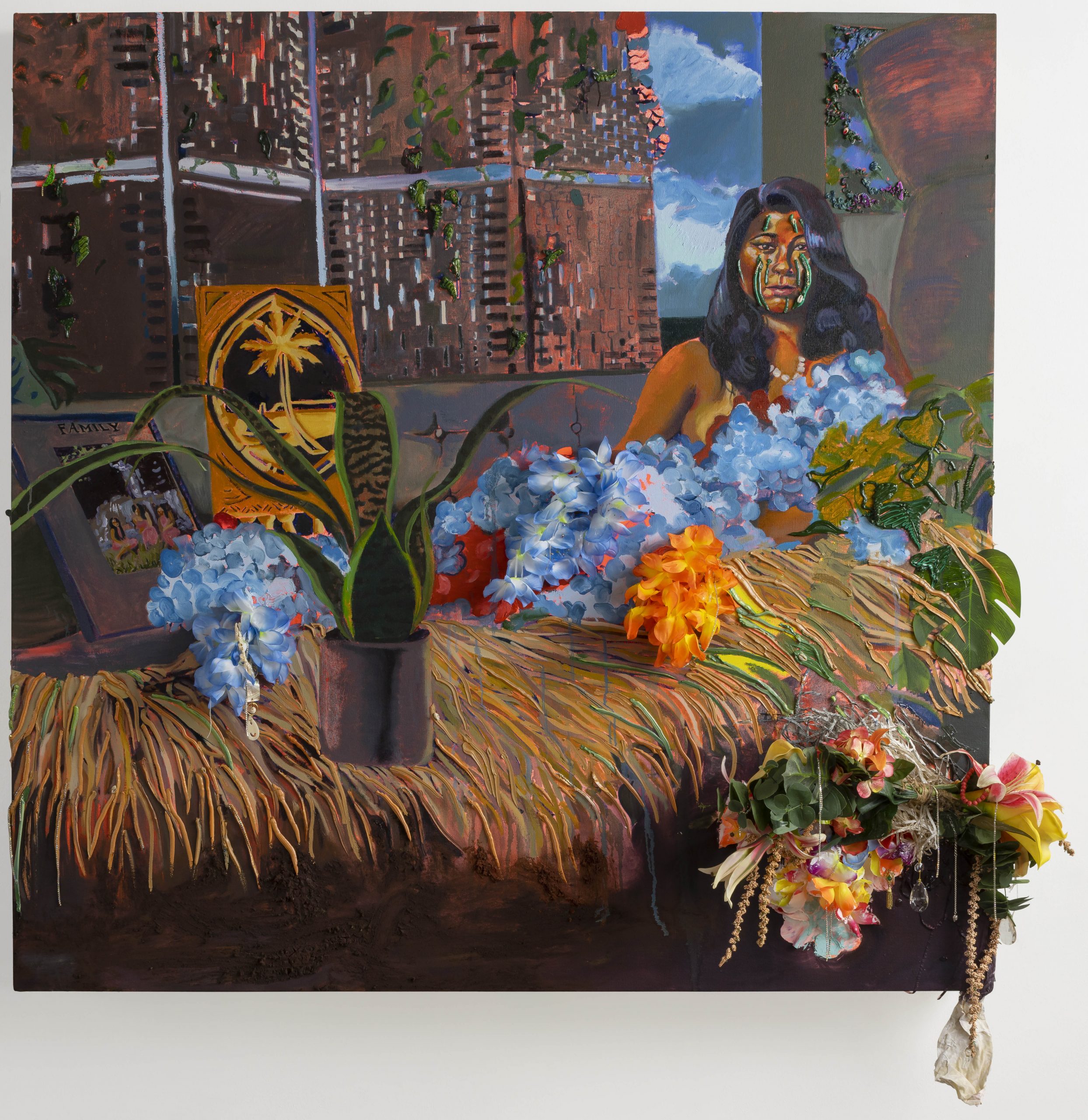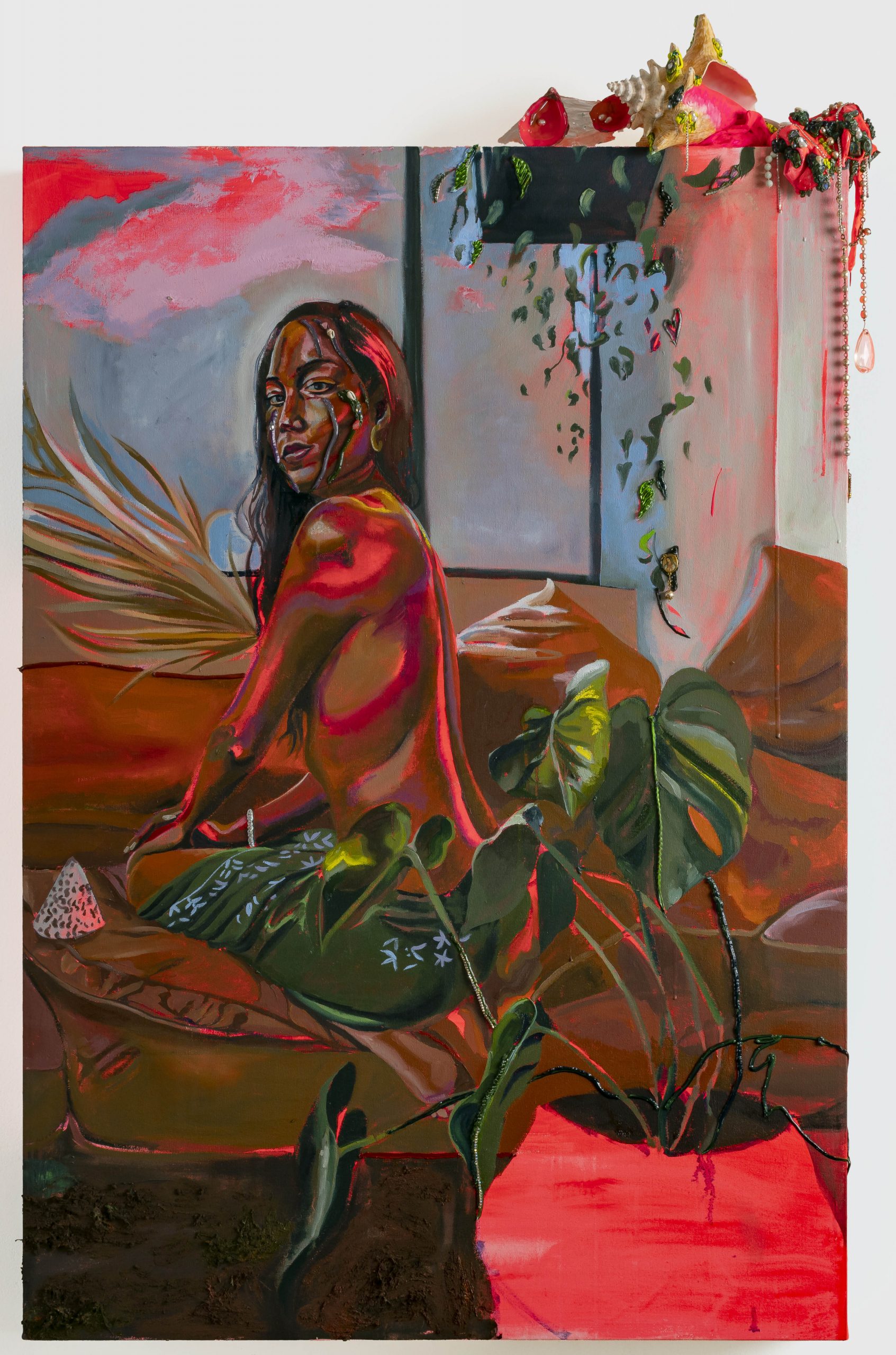
Paul Gauguin, Nevermore , 1897. © The Courtauld
When I was an undergraduate, a professor compared my palette and my way of working to those of Gauguin. I was kind of upset about that idea, upset about who has the right to certain spaces and people.
I remember visiting major museums and seeing Gauguin’s paintings. A lot of the women in them are young. They’re meeting your gaze and you wonder what their story is. You don’t know much about them. It seems more of a reflection on him and his presence there.
As a Pacific Islander, I would always sit back and not necessarily spend a lot of time close up with Gauguin’s works. Instead I would sit back and watch other people observe them. It felt very extractive. I wondered about consent with those works, whether the people in the pieces were happy with their depiction. Whether they knew that they were going to be displayed in this way for so many years.

For a long time I was thinking about reclaiming that palette, because I felt personally that it belonged more to me than him. If you visit the Pacific Islands, they are very vibrant, they smell like flowers. It’s beautiful. That’s home. Those are my ancestors, so for him to paint that felt like theft to me.
Talk story is the Pacific practice of story sharing
. When I was trying to heal from my own experiences, I searched for these intimate spaces, sharing with people who had similar experiences or similar identities. That process has carried on until now.

“Being indigenous, there are parts of my practice that I am willing to share with the art world. And there are parts that should be just for us”
Violence against women, violence against femme-identifying people and what Gauguin was ultimately doing on these islands, they go hand-in-hand. His relationships with his sitters were often problematic and as someone who’s had similar experiences to the sitters, I want to share those stories, the stories that were erased and that Gauguin assisted in erasing. The folks in those paintings don’t have a voice.

Paul Gauguin, “Aha Oe Feii?” (“What? Are You Jealous?”), 1892
I very intentionally choose not to use the word muse, because the folks that I work with are so much more than that to me. It’s a gift-giving process because people share their stories, and we collaborate to make them comfortable with being in the work. So much of my process is conversation. It’s asking: “What parts of your body are you comfortable with me painting? What do you want me to celebrate? How do you want to be posed? What objects are important for you to be documented with?”
“I want to share those stories, the stories that were erased and that Gauguin assisted in erasing. The folks in those paintings don’t have a voice”
Being indigenous, there are parts of my practice that I am willing to share with the art world. And there are parts that I don’t think we should need to explain, that should be just for us: objects, jewelries. There are precious parts that are just for us. When I’m working on the pieces, I’m not necessarily listening to the audio [of the conversations with sitters]. I am thinking about what it was like to sit with that person in that space in a cinematographic sense: what it felt like and what we were wrestling with.
- Gisela McDaniel, Måmes, 2021
- Gisela McDaniel, Prima, Nieta, Nåna: Pasifika Bailadora, 2021
Objects hold stories, objects hold significance. To put objects like jewellery in paintings feels protective. There are levels of protection I feel that are necessary for me to be comfortable with putting the work out. I’m dealing with other people’s stories that they’ve entrusted to me, I don’t feel comfortable just throwing them into the world. These layers of adornment—the masks, the lines on the faces—those are layers that you have to interact with before you can access the more intimate parts of the work. The first layer is me sitting with that person; the final layer is the recording of that space.
“I wondered about consent with Gauguin’s works, whether the people in the pieces were happy with their depiction”

A lot of people don’t know that Guam [where my maternal family originates from] is a US territory. There’s a lot of movement on the island at the moment, so it’s a privilege for me to be able to recount these narratives in the UK. There’s a lot that the native folks at home are fighting for. It would be an injustice for me to just paint without those stories attached.
Painting has always been my first language. Being able to challenge the history of painting, the history of portraiture, is important, because I had the privilege of growing up going to a lot of museums but I never saw people like us unless it was in Gauguin’s work. I see painting as history, and being able to paint the people I love and care about and respect, and put them in museums, is my goal. To put my loved ones, my family, my community in that canon of portraiture, in that conversation, is why I make paintings.
As told to Ravi Ghosh, Elephant’s editorial assistant








